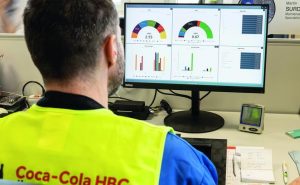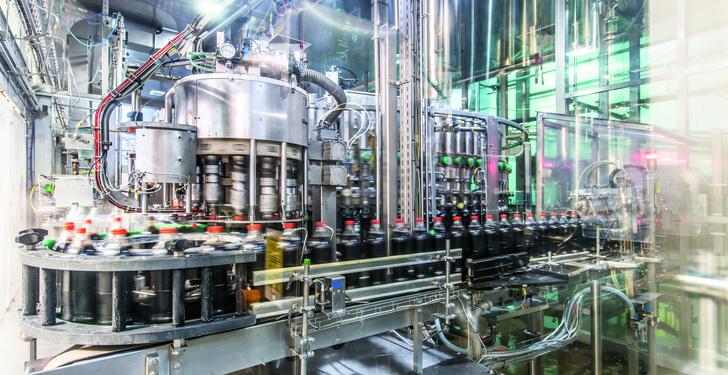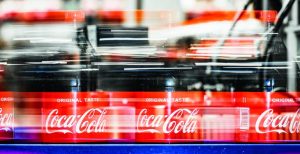Less waste, reduced water consumption, lower emissions – using an energy management system, the Coca-Cola plant in Edelstal, Austria, can now conduct detailed analyses of its resource and energy consumption. The goal is to reduce its carbon footprint even more.
One of Coca-Cola HBC Austria’s top priorities is to manufacture world-famous, high-quality beverage brands in line with market demand. “An equally important priority is that we use resources responsibly and manufacture our products in a way that’s as environmentally friendly and carbon-efficient as possible,” says Environment Manager Theresa Fleischberger.

One of the world’s fastest bottling plants
Not only is it one of the world’s fastest lines, but it’s also remarkably energy-efficient. Thanks to the new lines and increased use of air to clean bottles before filling, the amount of water consumed by production has been significantly reduced.
In addition, the company has already replaced the first high-pressure compressor for the blow molding machines on the PET lines. According to Maintenance Specialist Martin Surda, the new compressor consumes between five and eight percent less electricity, depending on operating conditions and capacity utilization.
Renewable energy sources
One-hundred percent of the electricity powering the plant is from renewable sources. Although the savings have no additional impact on the carbon footprint, “It’s still important that we improve our energy efficiency on an ongoing basis,” explains Fleischberger.
This is partly motivated by costs because the price of electricity and other fuels is constantly rising. At the same time, the plant consumes natural gas in addition to electricity, which means that savings in overall energy consumption also affect the carbon footprint.
Analyzing the lines’ energy consumption
Coca-Cola HBC Austria has already been tracking the success of its energy-saving measures in Edelstal with the aid of its own energy monitoring system. This system recorded production and consumption data and made it possible to analyze and compare the energy consumption of individual lines – but Surda still felt that his options were extremely limited.
The Coca-Cola plant in Edelstal began using the Simatic WinCC V7 system from Siemens to visualize production data. It then turned to Simatic Energy Manager Pro for energy management. “We were particularly impressed by the solution’s flexibility and scalability,” says Surda.
New energy management system
In just two months, energy management at Edelstal was transferred to the new system, which included the integration of numerous consumers that are captured by Sentron PAC energy measuring devices.
The consumption data is gathered by a Simatic ET 200SP system and then transferred to Simatic Energy Manager Pro. In addition to the measuring devices for electrical energy, flow meters for recording water consumption are also integrated with the system.
In-house energy management
After training from Siemens, the team headed by Fleischberger and Surda can now configure and operate the system completely independently. More than 100 data points for measuring energy consumption and 17 data points for water consumption are currently integrated with the system and are queried once per minute. The data acquired is linked to the production data from the ERP system, which enables a detailed analysis of energy consumption and energy efficiency for each individual product produced.
Reports in no more than an hour
New analyses and dashboards can also be created at any time and with little effort, says Surda. “We can now generate new reports in no more than an hour. We used to have to hire external programmers to do it for us, with the result that changes sometimes took a week or even longer. Now we can do it all ourselves.”
One additional benefit of Simatic Energy Manager Pro is that users can also view the data via a Web client – which is especially advantageous for Fleischberger, who works most of the week in Vienna.
„We can determine the exact consumption and costs for each individual line and each individual product. I consider this transparency to be an important benefit of the new system.” Theresa Fleischberger, Environment Manager at Coca-Cola HBC Austria
Increased environmental awareness
Even employees in production can now stay informed about current energy consumption. “This broadens the awareness of the issue. Each employee can contribute to boosting energy efficiency and see their success reflected in the numbers,” says Fleischberger. “Plus, the numbers we have access to are much more detailed. We can determine the exact consumption and costs for each individual line and each individual product. I consider this transparency to be an important benefit of the new system.”
Altogether, these measures have allowed Coca-Cola HBC Austria in Edelstal to reduce its CO2 emissions to 17.5 g per liter of beverage produced in 2019 – which is 50 percent less than in 2010.
Option for prompt system maintenance
Surda also plans to use information from Simatic Energy Manager Pro to improve system maintenance and prevent energy losses. “Among other things, we want to identify when leaks or other problems start based on flow measurements and energy consumption in the compressed air supply. This will allow us to service the systems promptly and in a way that saves money and resources.”
What’s more, Edelstal’s energy manager is about to be expanded. In 2020, the six high-pressure compressors in the compressed-air network will also be integrated with the system. These compressors generate air at a pressure of 36 bar that’s used to form PET bottles from blanks.
“We can then optimize the processes so that we consume less energy – for example, by reducing machine maintenance time and aligning the compressors more closely with our demand. Because these six units are responsible for about 20 percent of our energy consumption, the savings potential is tremendous,” says Surda.
Resource efficiency to be increased even more
“With Simatic Energy Manager, we can define savings goals and prove the cost-effectiveness of efficiency measures in the areas of water and energy,” says Fleischberger. The plan is to continue improving resource efficiency at the Coca-Cola plant in Edelstal with the help of the new energy management system.

